Special Senses- Smell, taste and vision
1/103
There's no tags or description
Looks like no tags are added yet.
Name | Mastery | Learn | Test | Matching | Spaced |
|---|
No study sessions yet.
104 Terms
Olfaction
Sense of smell
Occurs in response to odors stimulating sensory receptors in the olfactory region of the nasal cavity
Olfactory epithelium

Olfactory epithelium
Contains cell bodies and dendrites of ~10 million olfactory neurons
Dendrites extend to the epithelial surface
Olfactory vesicles
Olfactory hairs
Basal cells
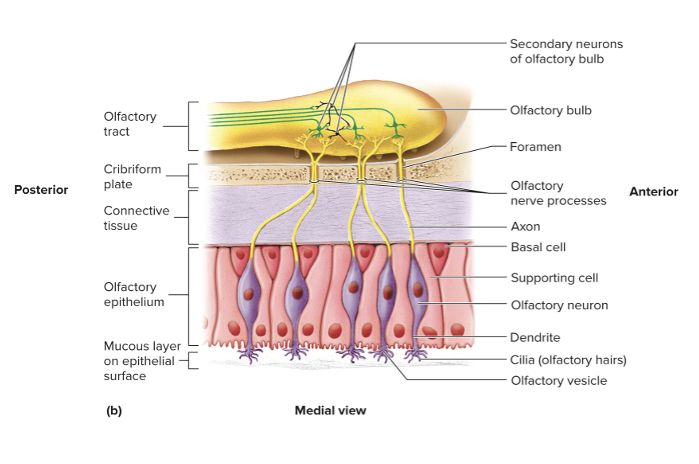
Olfactory vesicles
Bulbous enlargements at the ends of dendrites
Olfactory hairs
Cilia on olfactory vesicles that are covered in thin mucous film
Basal cells
Replace olfactory cells every 2 months
Odorants
Airborne molecules that enter into nasal cavity and dissolve in fluid covering the olfactory epithelium
Bind to odorant receptors (chemoreceptors)
1000 different odorant receptor molecules
Regulate multiple intracellular pathways involving G proteins, adenylate cyclase, and ion channels allowing for detection of ~4000 smells
Seven primary classes
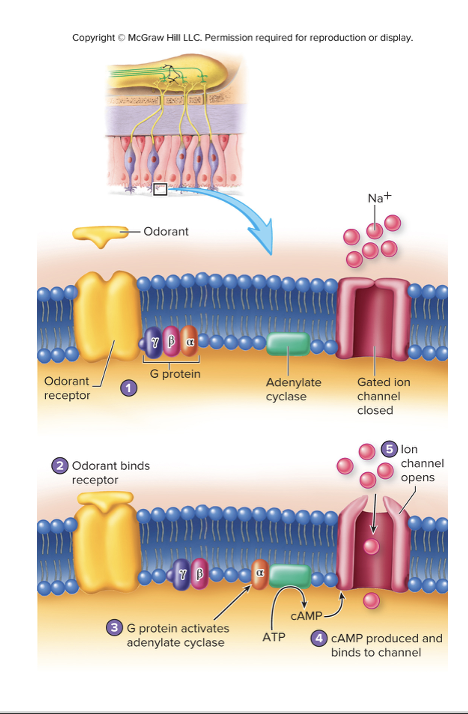
Seven primary classes
Camphoraceos (mothballs)
Musky
Floral
Pepperminty
Ethereal (fresh pears)
Pungent
Putrid
Neuronal Pathways for Olfaction
Complex pathways involving in multiple areas of the cerebrum
Olfactory stimuli causes perception of specific odors and emotional and autonomic responses
Majority of neurons in olfactory cortex areas in the temporal and frontal lobes to perceive odors
Piriform cortex
Some olfactory neurons project to secondary olfactory areas involved in emotional and autonomic responses
Include hypothalamus, hippocampus, and structures of the limbic system

Taste
Gustation
Taste buds
Sensory structures of taste
Small, oval structures located along the edge of papillae on the tongue, palate, lips and throat
Taste (gustatory) cells
Taste hairs
Basal cells
Supporting cells
Taste gustatory cells
About 50 sensory cells per taste bud
Taste hairs
Microvilli that extend through the taste pore of the taste bud
Replaced about every 10 days throughout life
Basal cells
develop into new taste cells
Supporting cells
Support taste cells
Lingual Papillae
Filiform
Vallate
Folliate
Fungiform
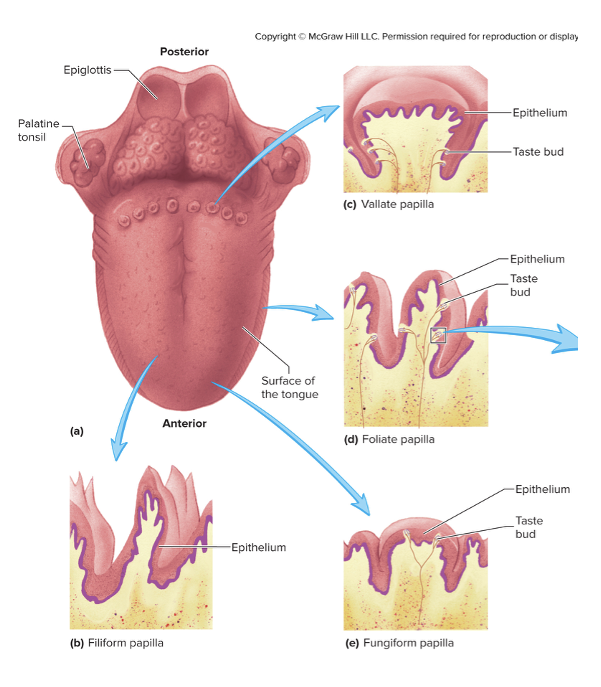
Filiform
Filament shaped
Most numerous
No taste buds
Give rough surface on tongue
Vallate
Largest and least numerous (8-12)
Form V-shaped row along the border and anterior and posterior parts of the tongue
Foliate
Leaf shaped
Folds on the sides of the tongue
Contain most sensitive taste buds
Numerous in children and decrease with age
Fungiform
Mushroom shaped
Scattered on the superior surface of the tonge
Tastants
Substances that dissolve in saliva and enter taste pores and stimulate taste cells
Have short connections that release neurotransmitters to secondary sensory neurons
Five taste classes
Five taste classes
Salty
Sour
Sweet
Bitter
Umami
SALTY
Na+ diffuses through Na+ channels on the surface of the taste cells causing depolarization
Low sensitivity
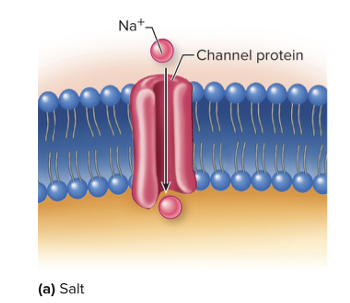
SWEET
Tastant (sugar) binds to G protein-couple receptor molecules on taste hairs of taste cells
Leads to depolarization
Low sensitivity

SOUR
H+ of acids cause depolarization by three mechanisms
Enter the cell directly through H+ channels
H+ bind to ligand-gated K+ channels and block K+ from exiting the cell
H+ can open ligand-gated channels for other positive ions allowing them to enter the cell
BITTER
Alkaloid tastants stimulate via G protein mechanism
Highly sensitive
Detects toxins
UMAMI
Results from amino acids (glutamate)
Depolarization via G protein mechanism
Influences of taste
Texture of food
Temperature of food
Adaptation of taste can occur within 1-2 seconds after perception complete adaptation within 5 minutes
Occurs at the level of the taste bud and in the CNS
Olfactory sensations
Neural Pathways for taste are carried by three cranial nerves
Facial nerve (CN VII)
Glossopharyngeal nerve (CN IX)
Vagus nerve (CN X)
Neuronal Pathways for taste
Axons of cranial nerves carry information to the tractus solitarius of the medulla oblongata
Fibers from the nucleus of the tractus solitarius extend to the thalamus and decussate at the level of the midbrain
Neurons from the thalamus project bilaterally to the taste areas in the insula of the cerebrum
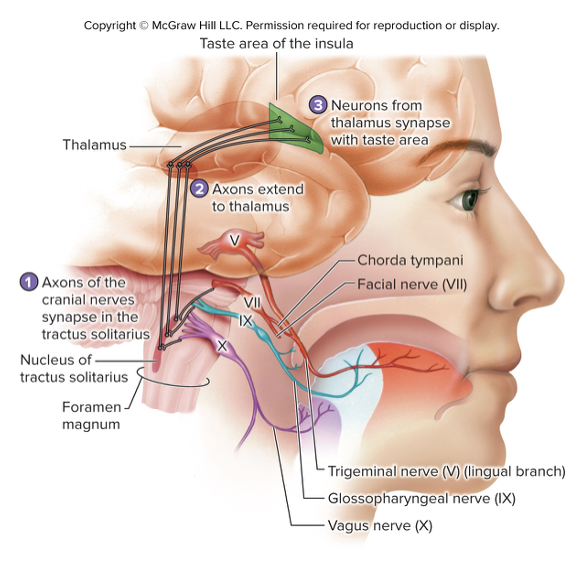
Three cranial nerves that carry taste
Facial nerve (CN VII)
Chorda tympani – branch of the facial nerve that transmits taste sensation from anterior 2/3 of the tongue
Glossopharyngeal nerve (CN IX)
Carries taste sensation from posterior 1/3 of the tongue, vallate papillae, and superior pharynx
Vagus nerve (CN X)
Carries taste sensation from the root of the tongue and epiglottis
Visual system
Includes eyes, accessory structures, optic nerves (CN II), and pathways
Eye
Optic nerve and tracts
EYE
Includes eyeball and lens
Respond to light and initiate afferent action potentials
Optic nerve tracts
Transmit action potentials from the eye to the brain
Accessory Structures of the Eye
Important for maintenance and protection of the eyes
Protect, lubricate, move, and aid in the function of the eye
Accessory Structures of the Eye includes:
Eyebrows
Eyelids
Eyelashes conjunctiva
Lacrimal apparatus
Extrinsic eye muscles
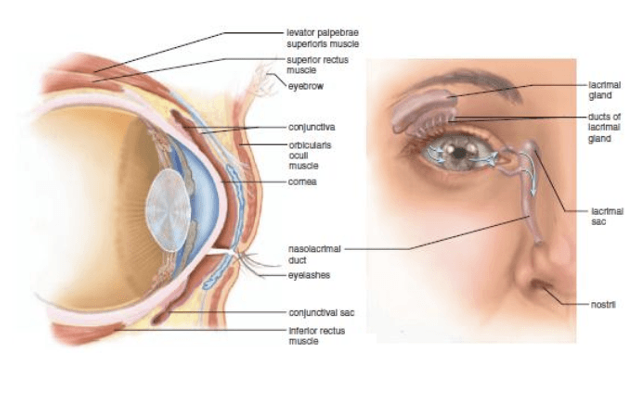
EYEBROWS
Hairs superior to the orbits
Prevents perspiration from running into the eye
Helps shade eye from direct sunlight
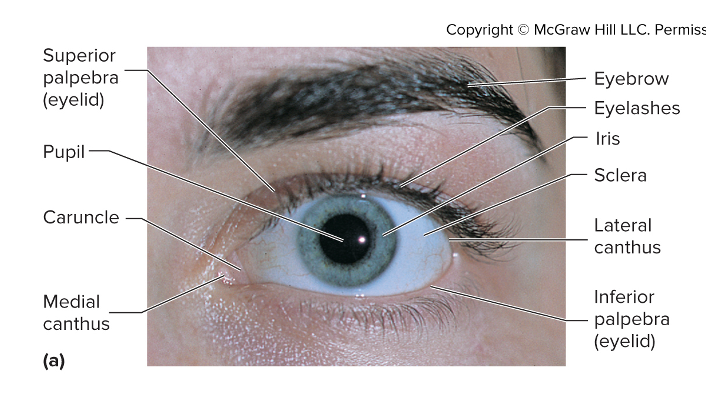
EYELIDS
With eyelashes protect eyes from foreign objects by blinking
Blinking helps lubricate the eye by spreading tears
Regulates amount of light entering the eye
Palpebral fissure – space between eyelids
Canthi – angles where the superior and inferior eyelids meet (medial and lateral)
Caruncle – small reddish/pink mound in the medial canthus, houses modified sebaceous and sweat glands
Eyelashes – 2-3 rows of hairs at the free edges of the eyelids
Ciliary glands – modified sweat glands that lubricate the eyelashes
Sty – inflammation of the ciliary glands
Meibomian (tarsal) glands – sebaceous glands near the inner margins of the eyelid that secrete sebum to lubricate the lids
Chalazion – infection or blockage of the meibomian gland
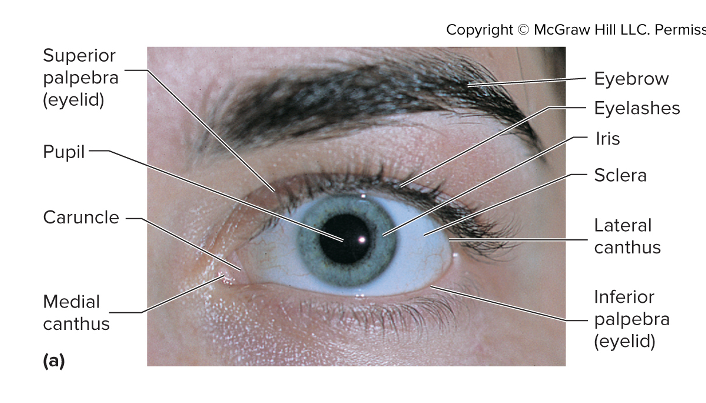
Sty
Inflammation of the ciliary glands
Meibomian (tarsal) glands
Sebaceous glands near the inner margins of the eyelid that secrete sebum to lubricate the lids
Chalazion
Infection or blockage of the meibomian gland
Layer of the eyelid superficial to deep
Thin layer of skin
Thin layer of areolar connective tissue
Layer of skeletal muscle (orbicularis oculi and levator palpebrae superioris muscles)
•Tarsal plate – crescent shaped layer of dense connective tissue helping to maintain shape of the eye
•Palpebral conjunctiva